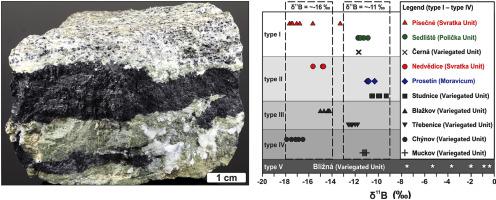Geoscience Frontiers ( IF 8.9 ) Pub Date : 2020-04-01 , DOI: 10.1016/j.gsf.2020.03.009 Lukáš Krmíček , Milan Novák , Robert B. Trumbull , Jan Cempírek , Stanislav Houzar

|
Various metacarbonate and associated calc-silicate rocks form minor but genetically significant components of the lithological units in the Bohemian Massif of the Variscan orogen in Central Europe. These rocks vary in terms of their lithostratigraphy, chemical composition and mineral assemblage (dolomite/calcite ratio, silicate abundance). Tourmaline is present in five paragenetic settings within the metacarbonate and calc-silicate units. Type I comprises individual, euhedral, prismatic grains and grain aggregates in a carbonate-dominant (calcite ± dolomite) matrix poor in silicates. Type II is characterized by euhedral to subhedral grains and coarse-to fine-grained aggregates in silicate-rich layers/nests within metacarbonate bodies whereas type III occurs as prismatic grains and aggregates at the contact zones between carbonate and associated silicate host rocks. Type IV is in veins crosscutting metacarbonate bodies, and type V tourmaline occurs at the exocontacts of elbaite-subtype granitic pegmatite. Tourmaline from the different settings shows distinctive compositional features. Typical for type I are Mg-rich compositions, with fluor-uvite > dravite >> magnesio-lucchesiite. Tourmalines from type II silicate-rich layers/nests are highly variable, corresponding to oxy-schorl, magnesio-foitite, Al-rich dravite and fluor-uvite. Typical for type III tourmalines are Ca,Ti-bearing oxy-dravite compositions. The type IV veins feature dravite and fluor-uvite tourmaline compositions whereas type V tourmaline is Li,F-rich dravite. Tourmaline is the only B-bearing phase in paragenetic types I–IV, where it is characterised by two principal ranges of B-isotope composition (δ11B = −13‰ to −9‰ and −18‰ to −14‰). These ranges correspond to regionally different units of the Moldanubian Zone. Thus, the Svratka Unit (Moldanubian Zone s.l.) contains only isotopically lighter tourmaline (δ11B = −18‰ to −14‰), whereas metacarbonates in the Polička unit (Teplá–Barrandian Zone) and Olešnice unit (Moravicum of the Moravo-Silesian Zone) has exclusively isotopically heavier tourmaline (δ11B = −9‰ to −13‰). Tourmalines from metacarbonates in the Variegated Unit cover both ranges of isotope composition. The isotopically light end of the B isotope range may indicate the presence of continental evaporites within individual investigated areas. On the other hand, variations in the range of ∼8 δ-units is consistent with the reported shift in B isotopic composition of metasedimentary rocks of the Bohemian Massif due to the prograde metamorphism from very-low grade to eclogite facies. In contrast to the metacarbonate-hosted settings, tourmaline of paragenetic type V from the exocontact of granitic pegmatites displays a significantly heavier range of δ11B (as low as –7.7‰ to –0.6‰), which is attributed to partitioning of 10B to cogenetic axinite and/or different B-signature of the source pegmatite containing tourmaline with heavy δ11B signature.
中文翻译:

波希米亚地块中的碳酸盐岩和伴生的钙硅酸盐岩石中的电气石中的硼同位素变化:瓦里斯卡造山带中硼再循环的限制
在中欧的瓦里斯坎造山带的波西米亚地块中,各种碳酸盐岩和伴生的钙硅酸盐岩石构成了岩性单元中次要但具有遗传意义的组成部分。这些岩石的岩石地层学,化学成分和矿物组成(白云石/方解石比,硅酸盐含量)均不同。电气石存在于碳酸根和硅酸钙单元的五个共生环境中。I型由贫硅酸盐组成的碳酸盐为主(方解石±白云石)基质中的单个,全金属,棱柱形晶粒和晶粒聚集体。II型的特征是在准碳酸盐体内的富含硅酸盐的层/巢中具有从全面到半面的晶粒和粗到细粒的聚集体,而III型则以棱柱状颗粒和聚集体的形式出现在碳酸盐和相关的硅酸盐基质岩石之间的接触区域。IV型在静脉中横穿碳酸酯体,V型电气石发生在Elbaite亚型花岗岩伟晶岩的外露接触处。来自不同环境的电气石具有独特的成分特征。I型典型的是富含镁的组合物,其中的氟铝石>德拉威>>镁铝镁矾石。来自II型富含硅酸盐的层/巢状的电气石是高度可变的,分别对应于氧-短波石,镁镁-辉沸石,富铝的德拉沃和氟-辉石。III型电气石的典型成分是含Ca,Ti的氧德拉莫石成分。IV型静脉具有Dravite和氟石碧玺组成,而V型电气石则富含Li,F。电气石是I-IV型共生中唯一的含B相,其特征是B同位素组成的两个主要范围(δ 11B = -13‰至-9‰和-18‰至-14‰)。这些范围对应于摩尔达努比亚地区的区域不同单位。因此,斯夫拉特卡单元(Moldanubian区SL)仅包含同位素打火机电气石(δ 11 B = -18‰至-14‰),而在波利奇卡单元(的Teplá-Barrandian区)和奥莱什尼采部(Moravo-的Moravicum metacarbonates西里西亚区)仅具有较重的同位素电气石(δ 11 B = -9‰至-13‰)。杂色单元中碳酸氢盐的电气石覆盖了同位素组成的两个范围。B同位素范围的同位素轻端可能指示单个研究区域内存在陆相蒸发岩。在另一方面,在范围内变化〜8 δ单位与波西米亚地块准沉积岩中B同位素组成的变化相一致,这是由于从极低品位到榴辉岩相的前移变质作用。与此相反的metacarbonate托管设置,从花岗伟晶岩显示一个显著较重范围的exocontact共生V型的电气石δ 11B(低至-7.7‰至-0.6‰),这归因于图10B的分割到同源的源的斧石和/或不同的B-签名伟晶岩含电气石重δ 11B签名。


























 京公网安备 11010802027423号
京公网安备 11010802027423号